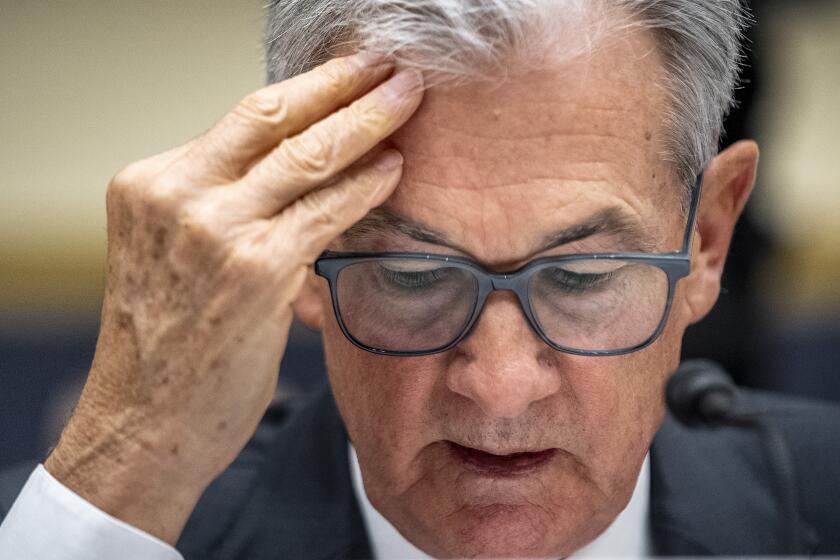Despite Amtrak crash, infrastructure spending remains low priority
- Share via
Last week’s horrific Amtrak crash outside Philadelphia has inspired much talk about the need to shore up America’s crumbling public infrastructure.
But the prospect of action on infrastructure hasn’t even notched upward as the Amtrak toll reached eight dead and more than 200 injured. The very day after the crash, House Republicans voted along party lines to cut Amtrak’s funding by nearly one-fifth.
They also turned away a Democratic proposal to add funds for a safety technology that might have averted the accident. There’s plenty of blame to go around: Only a few weeks ago, Democrats and Republicans on the Senate Committee on Commerce, Science and Transportation joined to delay by five years a mandate to implement the technology nationwide by the end of this year.
Infrastructure spending can be slotted into several categories: as the construction of physical works, such as highways and bridges; the deployment of safer or more efficient technical enhancements; or the provision of less tangible public services, such as broadband Internet service. Or as the maintenance and upkeep of existing works, or investments in human capital, such as K-12 schools or public universities. But however you define infrastructure, we’re not spending a fraction of what’s needed on any of it.
Small wonder that, as The Economist observed a few years ago, “America, despite its wealth and strength, often seems to be falling apart.”
The U.S. was ranked a dismal 25th on overall infrastructure quality in a survey of international business leaders published as part of the World Economic Forum’s 2012-2013 Global Competitiveness Report, down from fifth in 2002 and behind France, Germany, Canada, Portugal and Barbados, among many other countries.
The government’s failure to take advantage of rock-bottom interest rates to finance a major infrastructure program during the recession may well go down as one of the great lost opportunities in American history. Nominal 10-year Treasury rates dipped as low as 1.53% in mid-2012, a vicinity never seen except in the 1940s; two decades earlier they were close to 7%. Congress could have doubled or trebled the $800 billion appropriated for the 2009 stimulus package, modernized America’s economic bedrock to a degree rivaling the New Deal in the 1930s, and congratulated itself on a bargain well struck.
In some respects, the states are even further behind the curve. In its 2015 five-year state infrastructure plan, California Gov. Jerry Brown’s administration identified a $66-billion backlog in deferred maintenance needs, the largest chunk of which — $59 billion — belonged to Caltrans. Brown’s latest budget acknowledged a $6-billion gap in annual maintenance and repair funding for the state’s roads, but also stated that traditional sources of funding are running dry: The $20 billion in highway bond revenue provided by Proposition 1A of 2006 has largely been spent, as has the $964 million allocated for state highway upkeep from the 2009 federal stimulus package. Greater vehicle fuel efficiency has cut into the long-term prospects for the state fuel tax, which has been kept afloat by periodic rate increases.
More toll roads and possibly a mileage-based road usage charge loom in the future, but even these won’t be enough to fill the state’s maintenance and repair gap, according to the state budget. As for redeploying the nearly $10 billion in high-speed rail funding provided by Proposition 1A of 2008, that wouldn’t make much of a dent in the state’s long-term needs.
What’s really lacking in America’s infrastructure landscape isn’t money but political will and intelligent planning. From its peak in 1959 through 2014, public spending on transportation and water infrastructure declined by a fifth as a share of gross domestic product, to 2.4% from 3.0%, according to a Congressional Budget Office study earlier this year. Just maintaining the 1959 ratio of spending would have produced an average of more than $90 billion a year extra for those categories alone over the last decade.
Nor would it be pure spending. Repairing and maintaining America’s highways, rail lines, electrical grid and educational facilities often yield real gains in efficiency and savings, measurable in shorter commute times, faster Internet connections and a better-trained workforce. “Growing delays in air travel and surface transportation, bottlenecks in transmitting electricity and inadequate school facilities,” then-CBO Director Peter Orszag told Congress in 2008, mean that at least tens of billions in “additional infrastructure spending could be economically justifiable.”
Some of our infrastructure shortfall dates back to historical wrong turns. American rail peaked in 1916 at 254,000 miles, maintained its dominance in freight haulage and passenger transport through World War II, then suffered a precipitous decline in both categories, largely done in by cars and trucks.
Tom Zoellner, a rail aficionado who teaches at Chapman University and traveled around the globe for his 2014 book “Train: Riding the Rails That Created the Modern World,” noted in a Washington Post op-ed last week that European countries rebuilding after World War II concentrated their efforts on rail lines, often with U.S. aid through the Marshall Plan. The harvest was a modern system that accommodates high-speed trains and leaves American visitors weak-kneed with envy. “All the willpower in the United States, meanwhile, went into the Interstate Highway System — a pet project of President Dwight D. Eisenhower,” he writes. “Congress also saw it as a bonus to Texas oil companies and Detroit carmakers. The public-private prosperity dynamic had no patience for trains anymore.”
More recently, the congressional approach to infrastructure repair has been wholly reactive. The last big bump up in Amtrak’s budget came in direct response to the 2008 Union Pacific/Metrolink crash in Chatsworth that killed 25 people. One result was the mandate that rail systems nationwide implement “positive train control,” a tracking, communications and control technology that might have averted last week’s crash. But rail lines grousing about its cost — estimated to total as much as $22.5 billion — prompted the recent committee vote to defer the mandate. One of the few systems in the country still expecting to meet the year-end 2015 deadline is Metrolink, which will have spent $216 million on the effort.
Today, lawmakers intent on slashing public budgets don’t seem to be given pause even by clear signs of fatal defects in our national scaffolding. In their unrelenting quest for smaller government, they’re bequeathing future generations an economy not fit to compete in the 20th century, much less the 21st.
Michael Hiltzik’s column appears Sundays and Wednesdays. Read his blog, the Economy Hub, at latimes.com/business/hiltzik, reach him at [email protected], check out facebook.com/hiltzik and follow @hiltzikm on Twitter.
More to Read
Inside the business of entertainment
The Wide Shot brings you news, analysis and insights on everything from streaming wars to production — and what it all means for the future.
You may occasionally receive promotional content from the Los Angeles Times.











